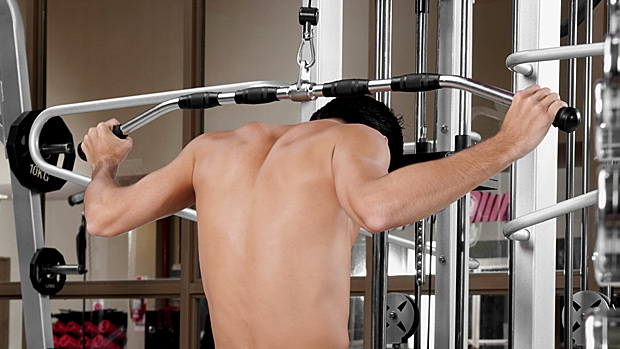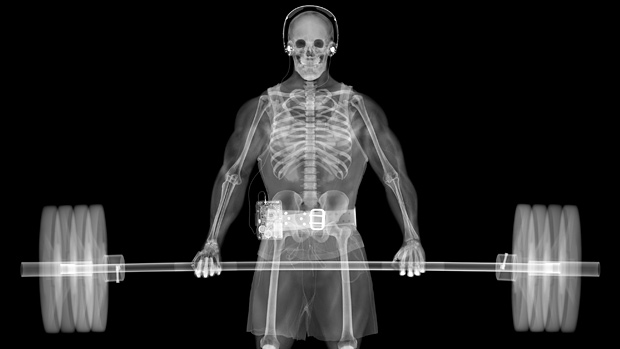Step One
If you want to get stronger and build an appreciable amount of muscle, understanding the foundational principles of training is the first step:
- Don't skip leg day.
- Focus on the compound lifts.
- Supplement the compound lifts with accessory exercises.
- Vary intensity, exercises, set-and-rep schemes, rest periods, etc.
- Prioritize peri-workout nutrition.
- Avoid eye contact while doing hip thrusts.
But it's not always a problem of doing what you "should" do – it's that you're doing a lot of what you shouldn't do. If you're committing a number of the following cardinal sins, it's only a matter of time until your progress stalls.
It doesn't matter what your goal is, if you want to get strong, build muscle, and boost performance, you can't go wrong by getting stronger.
Assuming your technique is dialed in, training with the sole intent of building strength will always deliver the best results in terms of body composition and performance while also improving bone density, joint health, connective tissue, etc. Lifting heavy isn't dangerous; being weak is dangerous.
How do you know if you're getting stronger? By regularly tracking your weights and setting personal records. This is the only way to ensure meaningful progress. Choose several key compound exercises to act as your indicator lifts and track how much weight you can do within a few different rep ranges. Over time, aim to beat those numbers and once you do – voila, you'll be bigger and stronger.
If you want to make any marked changes to your body, getting stronger is non-negotiable. When you focus on performance, your body composition will improve.
Periodization is often made out to be an incredibly complex subject. For the average individual who isn't peaking for a meet, though, the complexities are largely unnecessary.
In simple terms, periodization means alternating periods of higher volume (sets/reps) and lower intensity (weight/effort), with periods of lower volume and higher intensity.
Charles Poliquin used to say that the best program for you is the program you're not doing, meaning you need to incorporate different phases of varying sets, reps, and intensities into your training. Don't stick with one set-and-rep scheme all the time, and don't be afraid to lighten and/or increase loads (depending on the number of reps you're doing) as it becomes necessary.
Sometimes, go heavier. Other times, go lighter. The key is to get stronger across the board.
Some people like going heavy all the time. Others love "chasing the pump" at the expense of the strength-oriented set-and-rep schemes. If you're only focusing on one or the other, you're making a huge mistake.
This goes hand-in-hand with the concept of periodization – you NEED to spend considerable time training in different rep ranges, both within individual workouts as well as over time.
To get stronger, build muscle, lose fat, improve performance, or achieve any other goal, neglecting certain rep schemes and staying within your "happy" range will inevitably stall your progress.
There's absolutely no reason to add weight at the expense of perfect technique. Even elite powerlifters, whose primary goal is to lift as much weight as possible, focus on perfect execution in every lift. Why, then, is it so common to load up exercises at the expense of technique?
The weight being lifted is just a tool – it's the way you do an exercise that dictates your results. Optimal technique allows you to:
- Lift the most weight in the long-term
- Stimulate the targeted muscles most effectively
- Strengthen the mind-muscle connection
- Reduce the risk of acute and chronic injuries
Create full-body tension, control the weight, develop a mind-muscle connection, and work through full ranges of motion.
Excess variety can be the enemy of meaningful progress. If you're a chronic bite victim of the social-media-exercise bug and you switch up your routine on a weekly basis, you're not going to go anywhere. Determine your primary goals, follow a program based on those goals, and complete the program from start to finish.
Positive adaptations are a result of consistent training with repeated stimuli. Don't throw in cool exercises you see on Instagram, don't add in random WODs after your training, and stay away from excess "fluff" that doesn't align with your goals.
If you want bigger arms, choose the exercises that best align with that goal and stick to them for a set amount of time. But if you want to improve your deadlift, eliminate the curls and triceps extensions and use that time for back extensions, glute-ham raises, upper back work, etc.
If it's important to your goals, do it. If it's not, scrap it.

Doing the same programs that professional athletes and juiced-up bodybuilders do is a path that leads to nowhere. While some (key word: some) of these programs can be effective on paper, what these individuals are doing now is different from what they did to get to where they now are.
Cookie-cutter programs lead to cookie-cutter results. Training programs should be individualized to your needs and goals. Your strengths, weaknesses, goals, training history, anthropometrics, movement capabilities, lifestyle, and past injuries are all unique.
To optimize your training and stay healthy, figuring out what your body needs and adjusting your training as necessary is non-negotiable.
Warming up is the least fun part of training, but neglecting a proper warm-up will eventually lead to acute and/or chronic injuries. When you're injured, you can't train effectively – and when you can't train effectively, you can say goodbye to progress.
At the same time, don't swing too far to the other end of the spectrum by turning your warm-up into a full-fledged workout. There's no need to waste valuable training time by foam rolling your entire body from head to toe. The best prehab and rehab method is intelligent training, so employing a warm up that lets you get to where you can train effectively and efficiently is the ultimate goal.
Warming up doesn't have to be an arduous process. Spend a few minutes doing soft-tissue work, follow it up with some mobility drills and activations, hit some ramp-up sets, and then train. You're in it for the long-term, so play the long game and make warming up a priority.
There are two rules:
1 If something hurts, don't do it.
I'm not talking about ditching back squats because you stubbed your toe on the rack – I'm talking about actual pain. There's no need to force a certain exercise into your training because it's written on paper. There's more than one way to skin a cat, and the same concept applies to training.
Deadlifts are bothering your back? Pull from pins or use a trap bar. Your shoulders are acting up during an overhead press? Use a neutral grip bar, or bench on an incline. When you're banged up, focus on the muscles and the movements instead of particular exercises and come to terms with the fact that no exercise is absolutely mandatory.
2 Don't overlook stress.
If you slept terribly, had a long day at work, and got into a fight with your significant other on the way to the gym, don't be a hero – auto-regulate. Training is an additional stressor, whether you like it or not.
The days you push through fatigue and stress are the days you get hurt. Leave your ego at the door, be smart, listen to your body, and modify your training as necessary.
It's a cliché, but a chain is only as strong as its weakest link. If you have a weakness that's hindering your progress on certain lifts, make it a priority to spend extra time strengthening that area. If you can squat a house but struggle to help your buddy move his furniture because your deadlift is weak, that's a red flag.
In addition to keeping you healthy, strengthening your weaknesses can serve as a valuable tool to improve body composition and performance in the long-term. A lot of times, specific weaknesses are the bottleneck of muscle growth.
Common weaknesses include postural problems, muscular imbalances, a weak posterior chain, etc. Implement a specialized approach to strengthen your weak links and then reap the benefits.
Isolation exercises for the shoulders, arms, glutes, hamstrings, etc. have their place, but they should add to – not replace – the fundamental movements. Sure, isolation exercises can provide some benefits from an aesthetic perspective, but nothing can replace the powerful results that coincide with getting brutally strong at the basics.
If you weigh 150 yet struggle to complete more than 8-10 chin-ups, improve your ability to do chin-ups before even considering a set of curls. Before doing mini-band walks to isolate and "tone" your glutes, get stronger with squats, deadlifts, hip thrusts, glute-ham raises, and Romanian deadlifts.
When you develop foundational strength in the compound lifts, aesthetic results follow.





